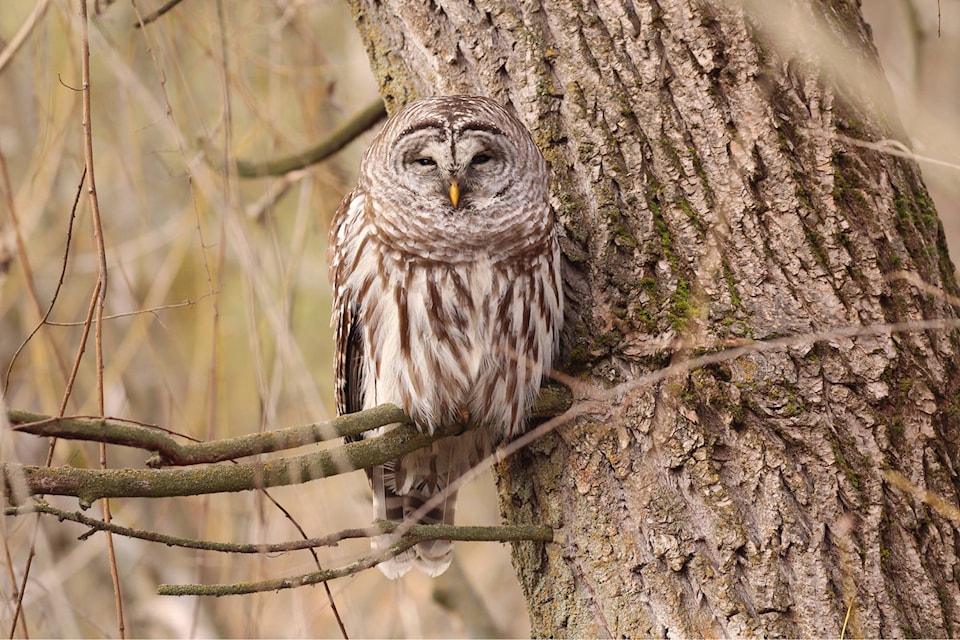Since owls prey is eaten whole or in big chunks, indigestible body parts (ie. bones, teeth, claws, fur, etc.) are regurgitated as a pellet. They’re usually black, dry masses about thumb size and shape. If you’re lucky, you might find owl pellets below a roosting spot.
Owls, like all wildlife, depend on wilderness to survive. But a few species can adapt to our urban landscape. Barred and Great Horned Owls are adapting well to natural urban areas.
Who’s who locally:
Great Horned Owl: Most common North American owl. Mostly nocturnal. Resident (stays year-round). In trees, including in residential areas, golf courses, parks and vineyards. Most adaptable, widespread, heaviest (3-4 lbs), largest eyed (human size), and longest lived (generally 15-20 years) of all our owls. Has a distinctive call of deep hoots.
Barred Owl: Frequently seen resident. Nocturnal. Bar-like patterns down its chest and dark eyes. Very intelligent, adaptive, varied diet. A series of quick hoots that resemble the melodic rhythm: “Who cooks for you? Who cooks all your food?” Possibly invasive from the east.
Short-eared Owl: Quiet and crepuscular (active in twilight). Swoops over fields and marshes especially around vole population “explosions .” Nests in shallow bowl scratched out in tall grass.
Long-eared Owl: Uncommon resident. Nocturnal, highly camouflaged and shy. Very long wings and long ear tufts. Nests and roosts in thickets near open field hunting grounds. Glides scanning for small mammals.
Snowy Owl: (Ookpik) Very rare fall migrant and winter visitor. Diurnal hunter. Heaviest North American owl with a thick down coat, fat and thickly feathered feet. Nests in Arctic.
Great Gray Owl: Crepuscular rare resident. Ghostly-shaped tallest North American Owl. Grey-feathered head with concentric-ringed bulls-eye face. Notoriously elusive blending into the forest.
Northern Saw-whet Owl: Nocturnal. Common woodland resident. In spring male “sings” monotonous regular single whistles. Cavity nester.
Western Screech Owl: Nocturnal, uncommon, secretive resident in riparian lowlands.
Boreal Owl: Nocturnal, secretive resident in higher altitude coniferous/mixed forests rarely shifting to lowlands in winter. Uses flicker cavities for breeding.
Northern Pygmy Owl: Small, uncommon, diurnal, fierce, visual bird and mammal hunters. Has two dark “eye spots” on back of head. Clear, measured “hook” whistles. Seen in Silver Star Mountain area. Breeds in higher elevation forests and some shift down to valley for the winter.
Barn Owl: Nocturnal, rare resident. Found in rafters of barns and abandoned buildings. Dark eyes on heart-shaped facial disk. Long legs. Short-lived (1-2 years to a maximum of eight years)
Northern Hawk Owl: Diurnal. Rare winter visitor. Long tail, pointed wings, swift direct flight, visual hunter (like accipiter hawks) to catch fast flying songbirds. Often perches conspicuously in open areas.
Flammulated Owl: North America’s smallest owl. Nocturnal. Large, black eyes. Mythically rare, elusive summer visitor. Quiet. Insectivorous. Migrates to Mexico and Central America.
Burrowing Owl: Small with long legs and Groucho Marx eyebrows. Was a former summer resident to grasslands of North Okanagan is extirpated (now locally extinct) since the early 1900s. They nest in underground burrows, but no longer breed naturally in the Okanagan due to habitat loss from cattle grazing, agriculture and from pesticide poisoning. Ongoing re-introduction programs tried for past 30 years.
Be cautious and quiet near owls; they need their sleep.
Don’t use rodent poison or insecticides. They can inadvertently kill owls and other wildlife.
Many thanks to local ornithologist, Chris Siddle, for his help with this article.
Check my Facebook site for favourite bird field guides.
Roseanne shares her knowledge of the outdoors to help readers experience and enjoy nature. Follow her on Facebook for more.
READ MORE: Get Outdoors! and give a hoot about owls
READ MORE: Get Outdoors!: What’s going on under the ice in the Okanagan?
